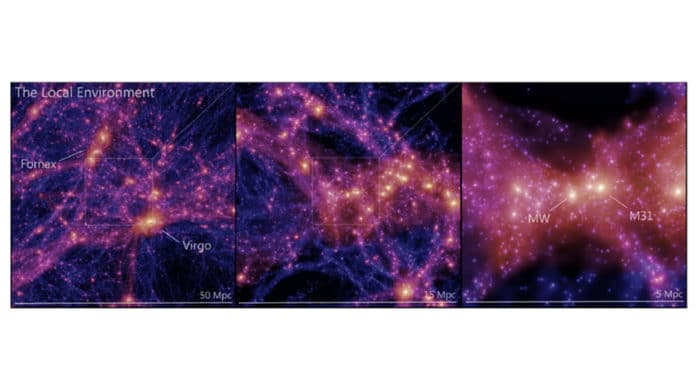Using supercomputer simulations, a team of international scientists has recreated the entire evolution of the cosmos, from the Big Bang to the present. They have produced the largest and most accurate virtual representation of the universe.
Scientists titled their simulation SIBELIUS-DARK. It is a part of the Simulations Beyond the Local universe (SIBELIUS) project.
Scientists developed the simulation using relevant physics equations to describe how dark matter and cosmic gas evolve throughout the universe’s lifetime.
By comparing the virtual universe to observational surveys, the team identified the precise locations and properties for the virtual analogies of the familiar structures. They found that our local patch of the universe is rare as the simulation predicted a lower number of galaxies on average due to a local large-scale ‘underdensity’ of matter.
The study includes scientists from University of Helsinki and Durham University in the UK.
Scientists did not consider the level of this undersensity as a challenge to the standard model of cosmology. Still, it could have consequences for interpreting information from observed galaxy surveys.
The simulation covers a volume of up to 600 million lightyears from Earth and is represented by over 130 billion simulated particles.
The simulations carried out in this study are different. Scientists used advanced generative algorithms to condition the simulations to reproduce our specific patch of the universe. Thereby, it consists of the present-day structures near our galaxy.
Professor Carlos Frenk, Ogden Professor of Fundamental Physics at the Institute for Computational Cosmology, at Durham University, said: “It is immensely exciting to see the familiar structures that we know exist around us emerge from a computer calculation. The simulations reveal the consequences of the laws of physics acting on dark matter and cosmic gas throughout the 13.7 billion years that our universe has been around. The fact that we have been able to reproduce these familiar structures provides impressive support for the standard Cold Dark Matter model and tells us that we are on the right track to understanding the evolution of the entire universe.”
Dr. Matthieu Schaller from Leiden University added: “This project is truly ground-breaking. These simulations demonstrate that the standard Cold Dark Matter Model can produce all the galaxies we see in our neighborhood. This is a very important test for the model to pass.”
Former Durham Ph.D. student Dr. Stuart McAlpine, a postdoctoral researcher at the University of Helsinki, said: “By simulating our universe, as we see it, we are one step closer to understanding the nature of our cosmos. This project provides an important bridge between decades of theory and astronomical observations.”
Journal Reference:
- Stuart McAlpine et al., SIBELIUS-DARK: a galaxy catalog of the Local Volume from a constrained realization simulation, Monthly Notices of the Royal Astronomical Society (2022). DOI: 10.1093/mnras/stac295
